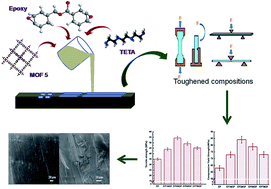Toughening of epoxy resin using Zn4O (1,4-benzenedicarboxylate)3 metal–organic frameworks†
Abstract
In this paper, we have demonstrated the potential of the well-known microporous MOF 5 towards toughening of a cycloaliphatic epoxy resin by preparing Epoxy–MOF 5 composites (0.1–0.7% w/w). Introduction of MOF 5 led to significant stiffening and improvement in dynamic properties as indicated by a 68% increase in impact strength and a 230% increase in fracture energy at an optimal loading of 0.3% w/w. A comparison of the mechanical response under different strain rates established the strain rate sensitivity of the composites, which is of relevance under blast loading conditions. We also performed fractographic analysis of the ruptured surface to understand the underlying mechanism behind the improvement in toughness.


 Please wait while we load your content...
Please wait while we load your content...